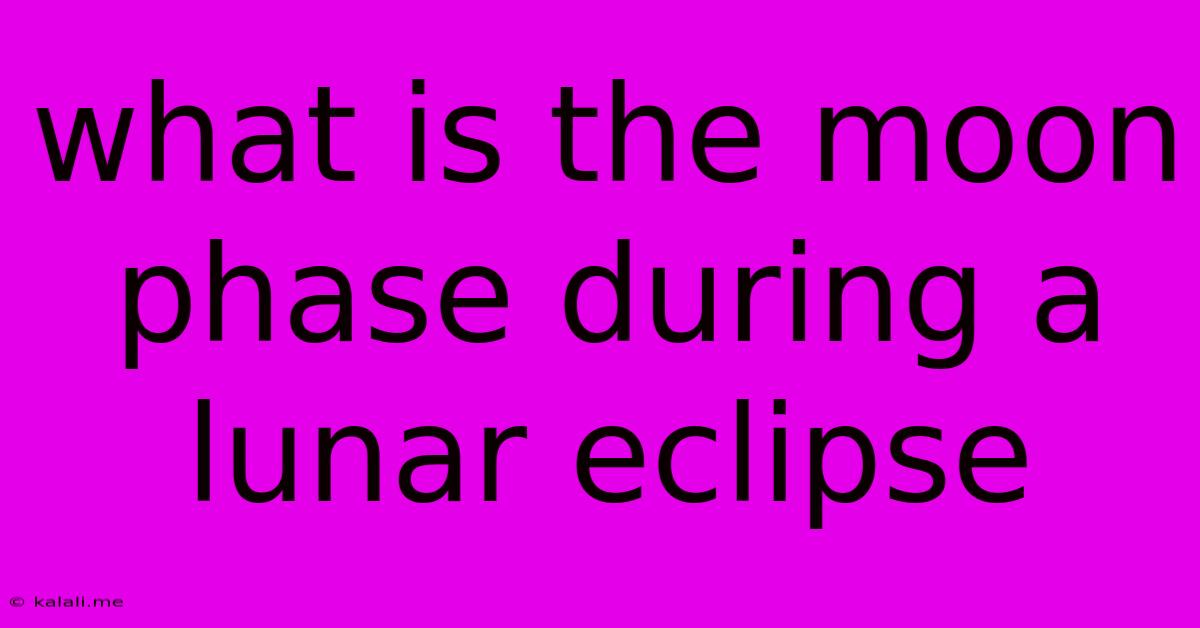What Is The Moon Phase During A Lunar Eclipse
Kalali
May 10, 2025 · 3 min read

Table of Contents
What is the Moon Phase During a Lunar Eclipse?
A lunar eclipse only occurs during a full moon. This is because a lunar eclipse happens when the Earth passes directly between the Sun and the Moon, casting its shadow on the Moon. This alignment is only possible when the Moon is on the opposite side of the Earth from the Sun, a configuration that defines the full moon phase. Understanding this fundamental alignment is key to grasping the relationship between lunar eclipses and the lunar cycle.
Understanding the Lunar Cycle and Full Moons
The Moon orbits the Earth, completing a cycle approximately every 29.5 days. During this cycle, we see different phases of the Moon, from a new moon (invisible to us) to a full moon (fully illuminated). The full moon phase is when the Moon is completely illuminated by the Sun's light, as seen from Earth. This is precisely the moment when a lunar eclipse can take place. The positioning of the sun, earth, and moon are critically aligned to make this celestial event possible.
The Mechanics of a Lunar Eclipse
A lunar eclipse isn't simply a full moon; it requires a specific alignment. The Earth's orbit around the sun and the Moon's orbit around the Earth are not perfectly aligned. Therefore, full moons don't always result in eclipses. A lunar eclipse occurs only when the Earth's shadow falls on the Moon, completely or partially obscuring it.
There are three types of lunar eclipses, all occurring during a full moon:
-
Total Lunar Eclipse: The entire Moon passes through the Earth's umbral shadow (the darkest part of the shadow). This results in the Moon appearing reddish, often referred to as a "blood moon."
-
Partial Lunar Eclipse: Only a portion of the Moon passes through the Earth's umbral shadow. Part of the Moon remains brightly lit while the other is darkened.
-
Penumbral Lunar Eclipse: The Moon passes through the Earth's penumbral shadow (the outer, fainter shadow). This type of eclipse is subtle and often difficult to notice without specialized equipment.
Why is the Moon Red During a Total Lunar Eclipse?
The reddish hue during a total lunar eclipse is a fascinating phenomenon. As sunlight passes through the Earth's atmosphere, shorter wavelengths of light (like blue and green) are scattered, while longer wavelengths (like red and orange) are bent and refracted towards the Moon. This scattered light illuminates the Moon, giving it the characteristic blood-red or copper-colored appearance. The exact shade of red can vary depending on atmospheric conditions on Earth.
In Conclusion
To reiterate, the only moon phase during which a lunar eclipse can occur is a full moon. While a full moon is a necessary condition, it is not a sufficient condition; perfect alignment is crucial for an eclipse to happen. The next time you witness a lunar eclipse, remember the precise celestial mechanics and the beautiful interplay of light and shadow that make this astronomical event possible. Understanding the relationship between the full moon, the Earth's shadow, and the resulting spectacular show of a lunar eclipse elevates the viewing experience to a whole new level.
Latest Posts
Latest Posts
-
What Is The Average Iq For A 9 Year Old
Jul 13, 2025
-
How Long Does It Take For Brandy Melville To Ship
Jul 13, 2025
-
How Many Times Does 3 Go Into 30
Jul 13, 2025
-
In What Episode Of Bleach Does Ichigo Ask Orihime Out
Jul 13, 2025
-
How Much Is 4 Oz Chocolate Chips
Jul 13, 2025
Related Post
Thank you for visiting our website which covers about What Is The Moon Phase During A Lunar Eclipse . We hope the information provided has been useful to you. Feel free to contact us if you have any questions or need further assistance. See you next time and don't miss to bookmark.